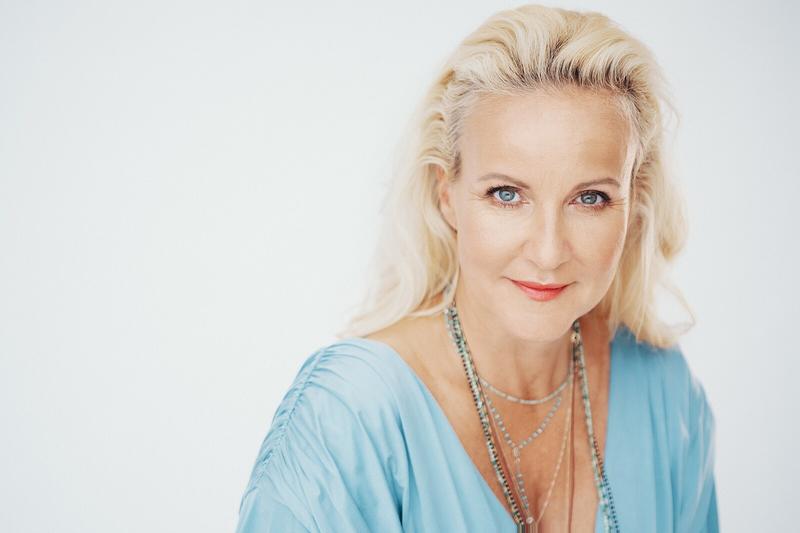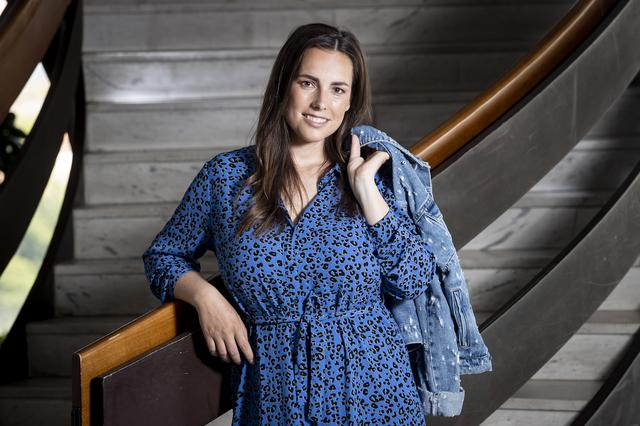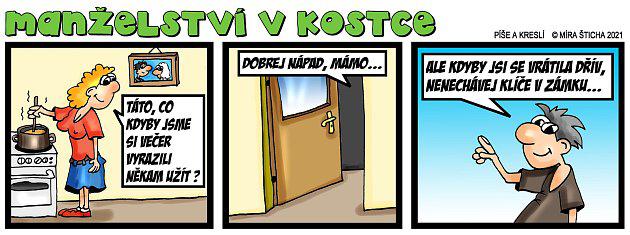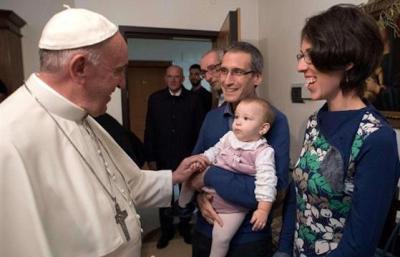A large tilt of the head does not mean that the child “beautifully holds the head”<
Iva Bílková is an extremely energetic woman, the mother of three children and the main physiotherapist of the Prague physioclinic she runs with her husband.He speaks ignorantly about the development of infants, for illustrating the problem does not hesitate to jump on the table and demonstrate the individual phases on himself.During her practice of therapist and mom, she sometimes encounters a claim she calls for harmful myths traded for generations.
"Our grandmothers did not know everything right," he says definitely when we come across the topic "grazing of horses", ie positioning babies on the tummy.
Head like half of the chest
"But he holds the head beautifully!" You may have heard a similar appreciation of the performance of a small child "grazing hobbies" many times.But the head is disproportionately large and heavy to the body and the strength of the individual muscles within three months of age.”To give you an idea, it is as if an adult wore a head of up to half of his chest.Such a burden cannot carry the muscles in the area of the spine and the deep stabilization system of a small baby.The situation then forces him to involve 'bad' muscles that the brain fixes in further development.The defective posture is then projected until adulthood, ”says Iva Bílková.
Co se děje při předčasné pozici na bříšku:
Source: Physioclinic
According to an experienced physiotherapist, the child should spend only the necessary time in the abdominal position within three months of age - for a moment when bathing, repacking or during a look at a doctor.”Only between 12.and 18.The baby's week of life occurs synchronous activity of his deep muscles from the cervical to the lumbar spine and the interplay of direct and oblique abdominal muscles.This will also start to manage the attempts to turn the back on the tummy, ”he describes.At that time, the time is still coming that the child can spend on the stomach.Must first be able to turn from the back on the side and to keep the position without being uncoordinated.
But here we encounter a problem - not only grandmothers but also many pediatricians recommend to position the baby on the tummy practically since birth.So who is right and how are parents to confess?
Where the rush
Generation of mothers and grandmothers in knowledge of the child's psychomotor development and in an attitude where the right time is for different activities.”While it was common children to set prematurely (even on the potty), put in the walkers or hold the walks for both their raised arms, today's mothers reject these methods.They themselves instruct grandmothers that the soft bones and joints of the baby still the weight of the head in an upright position will not hold that there is pressure on the organs in the chest and deformation of the spine.They know that the child must have muscles developed enough to be able to maintain an upright spine against the gravitational force of the Earth, ”says Iva Bílková.
”Many experts still believe that by laying on the tummy several times a day for as many minutes as the baby lasts, it strengthens the cervical and back muscles."Physiotherapist Iva Bílková disagrees with that.
We were wondering if at least experts in this matter and where guaranteed recommendations are taken.The first place where newly baked parents absorb advice and instructions are maternity hospitals.
Maternity: Individual approach is required
Mum with stormy emotions and hormones already receives a number of instructions in the maternity hospital, which then at home - plus minus - tries to follow.They come - often contradictory - dad's advice, friends, grandmothers, pediatricians, many fat books and "omniscient" of the Internet ... What does it learn about the position on the tummy from neonatologists, ie specialists in the care of newborns?
Neonatologists warn that the position on the abdomen is risky in terms of sudden death (SIDS), so the child must be vigilant and permanently under the supervision of an adult!

”The positioning of newborns and infants on the abdomen is important in terms of their correct psychomotor development.However, there is no generally valid recommendation to their positioning, but on the contrary, an individual approach is necessary, ”says my hopes to the clear answer DOC.Jiří cake, Chairman of the Czech Neonatology Society of ČLS JEP and head physician of the Neonatology Department of the University Hospital in Pilsen.Parents should therefore get information of individual nature;Nevertheless, for the purposes of this article, the head physician with his collaborators from the neonatology department of the Pilsen Hospital, physiotherapist Jana Knězová and doctor Monika Kepková, prepared the following recommendations:
”We can position the child on the belly when it is ready for it.A healthy newborn can be positioned on the abdomen in the waking state for a short time several times a day from birth.A condition for stay in the abdomen in terms of safety is the necessity of permanent supervision of an adult.”
Although it may seem that with the opinion of physiotherapist Iva Bílková, experts from Pilsen difference, no recommendations for positioning on the tummy will not sound here.Only expression of this option, moreover, with the exception of the so -called.Hypertonic children to which we will still get.Jana Knězová, an experienced and respected physiotherapist of newborns, explains this comment: ”I definitely agree with my colleague that putting a child on the tum.Lifting the head must be short -term and the child must be able to lay the head again.Location on the stomach is about the support of the hand.The kid must be ready for that and prepares in the back position.Stability on the back is the foundation, the child attracts the legs to the tummy and the hands reach the toys.This strengthens the hands so that they can lean against them on the tummy.” I ona však říká, že každé dítě je jiné, a proto nelze odpovědět obecně a jednoznačně, vždy záleží na věku a stavu dítěte.
A baby with a higher tension of muscles on the tummy definitely does not belong
For example, in children with hypertonic syndrome (ie.with a higher muscle voltage) position on the tummy neonatologists are not strongly recommended.These children may deteriorate hypertone.If the child does not manage the position, it is dissatisfied and its condition is getting worse.”In this case, it is necessary to stabilize the position on the back first (achieve normal muscle tension, ensure horizontal sitting, ie.The child lies on the back with crushed legs, the upper limbs are in the middle position).By suitable inhibitory exercises, the child is released until increased muscle tension adjusts. Pak dítě získá schopnost správné opory o horní končetiny a stává se na bříšku stabilním a spokojeným,” popisuje primář Jiří Dort.
In addition, Jana Knězová says that higher muscle tension in babies is sometimes caused by the inappropriate treatment of loving parents.”The position on the tummy is getting worse in these children, the tension increases and causes the so -called.Opistotonus, a large tilt of the head that is sometimes called pediatricians as 'beautiful holding of the head'.”
The physiotherapist also encounters an opinion - albeit exceptionally - that if a child cannot be on the tummy, you must often put it there. „To je veliká chyba,” varuje.
Pediatricians: On the tummy calmly from birth
So we start from the maternity hospital and we have no reason to put the baby on the tummy.But, look, just visit a pediatrician and everything is different. „Svým maminkám doporučuji pokládat na bříško krátkodobě od novorozeneckého věku,” odpovídá na dotaz dětská lékařka Alena Šebková, předsedkyně Odborné společnosti praktických dětských lékařů.However, she also points out the exceptions: the aforementioned hypertonic children and babies with significant predilection, ie those who prefer one side, or penetrate in their backs;Here you need to work with these phenomena first.”The position on the abdomen is only suitable when it corresponds to the above, the child must not scream on the abdomen, drain, attack etc.”
Although the doctor herself refers to the physiotherapist Jana Knězová, with whom she also works, she does not agree that the baby should be laid on the tum. „Na boky se dítě samo obrací až kolem čtvrtého měsíce, a to by již poloha na břiše měla být víceméně stabilní,” říká pediatrička.
Pediatricians often recommend positioning on the tummy, since birth. „Nemohu souhlasit s tím, že by dítě mělo být polohováno na bříško až kolem čtvrtého měsíce,” říká Alena Šebková.
What to do with these contradictions?So I'm looking for more information with Ilona Hülle, the chairwoman of the GPs Association for Children and Adolescents.And even this pediatrician recommends positioning on his tummy from the newborn age:.During the first visit to the family, the education of this positioning is part of the information we serve to mum.At the same time, we will show my mother how to position the child on the tummy.” Současně však upozorňuje na rozdíl mezi „polohováním” a „polohou”: „Je nutné si ovšem polohování neplést s polohou dítěte na bříšku v postýlce na delší dobu (hodiny) či na spaní.This is dangerous in newborns and infants in the first months of life, as there is a risk of inhaling milk in nabling or vomiting a baby that can lead to child suffocation.For the position of the baby on the tummy is a suitable age where the baby can actively turn from the tummy to the side or back.”
Physiotherapists warn just a few minutes of stay on the tummy, the doctor does not see the problem: ”Time spent on the tummy under supervision may be longer, a few minutes to watch the baby's behavior, and we are not afraid of even if he does not like it initially. O to častěji polohování na bříško opakujeme,” říká dokonce Ilona Hülleová.”There is no problem to leave the child for a long time in this position, it is suitable for the child and it is recommended by child neurologists.If the baby cries or is tired of the so -called.by grazing hobbies, then we recommend changing the position.In the case of healthy babies this is suitable.”
Physiotherapist Iva Bílková is aware of the contradictions in the recommendations and would therefore welcome closer cooperation with pediatric doctors.As Ilona Hülle confirms, there is no recommended procedure that is jointly elaborated by professional companies representing pediatricians, general practitioners for children and adolescents, pediatric neurologists, rehabilitation physicians or physiotherapists.”Pediatric doctors are published in their recommendations from expertise gaining by studying pediatrics, neonatology, including the study of the child's psychomotor development and its differences.Pediatric doctors are educated in the framework of postgraduate education lifelong. V rámci odborných seminářů pro praktické lékaře pro děti a dorost byly pořádány také semináře zabývající se touto problematikou,” uvádí.All the more confidence in the recommendations of experienced physiotherapists and pediatricians.
When you don't know, consult.But not with my grandmother
”Premature seating, building, but also hopping on lap with small babies is already pediatricians and parents rubbed.'Hobbies', however, remains a rooted danger. Nejmenším dětem může způsobit svalové a kosterní problémy po zbytek života,” uzavírá svůj pohled Iva Bílková, hlavní fyzioterapeutka FYZIOkliniky."The child should not be laid on the tummy, 'play' until it is sufficiently developed, which occurs between 12.and 18.a week of life.”
Následky předčasné polohy na bříšku:
Source: Physioclinic
Similarly, Jana Knězová, a physiotherapist of the neonatology department of the University Hospital in Pilsen, summarizes:.”
It also points out that there is a difference between laying a child on the tummy and positioning, which is a rehabilitation element under the guidance of a physiotherapist:.” Pokud si totiž nejste jistí, zda se vaše miminko správně vyvíjí, specializovaný fyzioterapeut vám dokáže poradit a pomoci.Some maternity hospitals and pediatricians also cooperate with them. „V Plzni je vcelku dobrá komunikace mezi fyzioterapeuty a pediatry, ale pravda – někdy rodiče neposlouchají a řídí se raději radami babiček, které jsou občas velice aktivní,” popisuje zkušenosti Jana Knězová.If grandmothers come with their mothers to rehabilitate and listen to what they explain to them, they finally recognize: “You're right, but no one first told us.” Pokud však nepřijdou, většinou maminky opakují názor babiček: „Prosím tě, já jsem vychovala tři děti, tak mi nějaká taková nebude radit…”
„My jsme byli na bříšku a také jsme vyrostli,” zní obvyklý „protiargument” na varování fyzioterapeutů.Certainly, you will grow out of the premature position on the tummy. Pravda, podle fyzioterapeutů možná poněkud „křivě”, bolavě.It is not useless?
Read: walkers, hoppers, jumps - for children completely inappropriate


 Tags:
Tags: Prev
Prev







